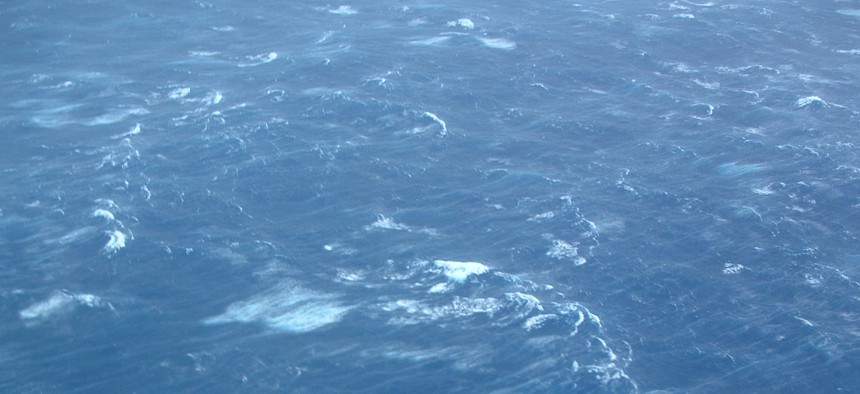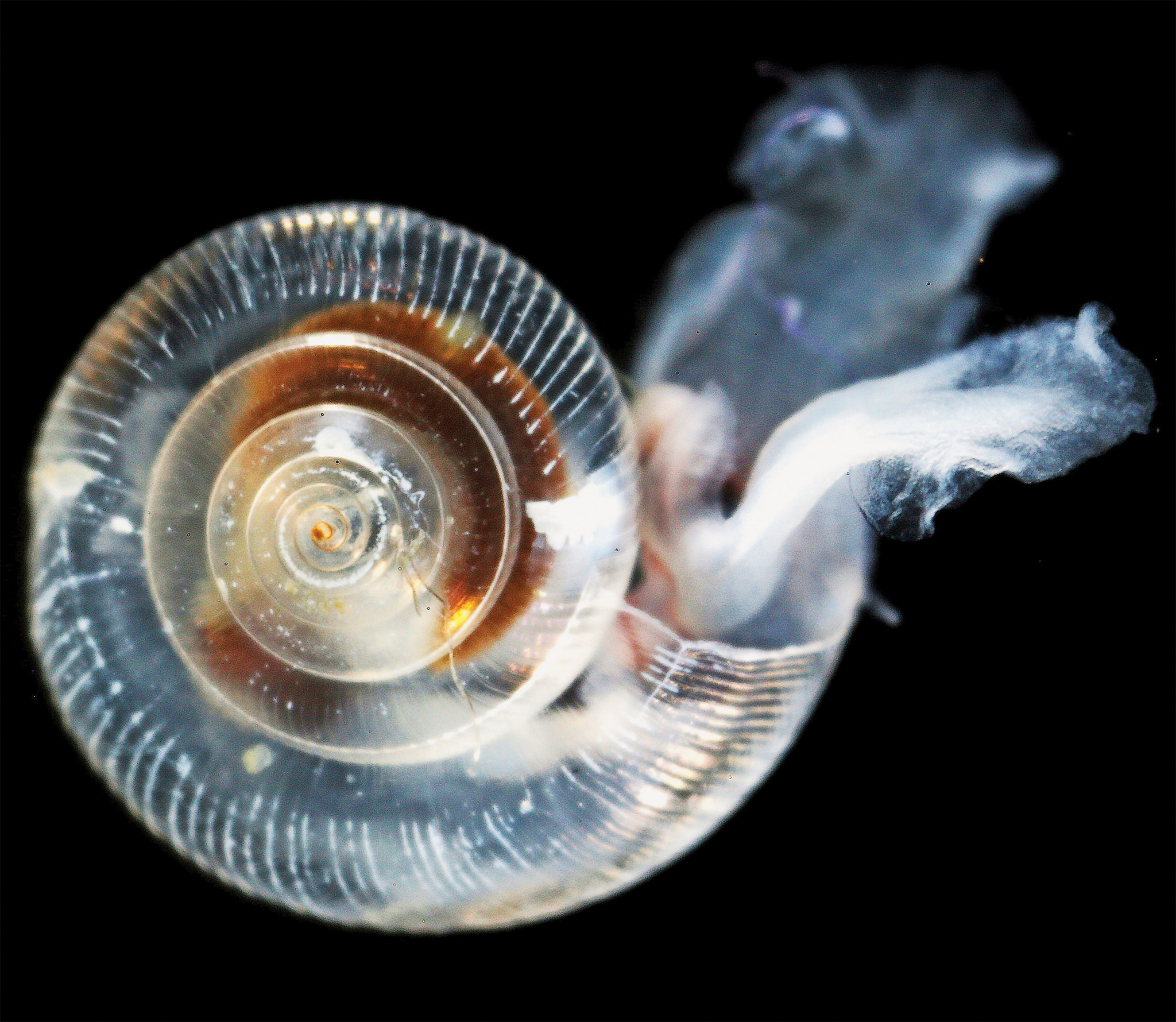
NOAA/OAR/AOML/Hurricane Research Division
Why the EPA Doesn't Regulate Ocean Acidification
In part, it’s because no one knows how best to do it yet.
Imagine that a recently discovered pollutant prevented trees from forming leaves. Every April, buds would spring from the branches, and kids on their way to school would point to the tiny shoots of green and pink. But as the leaves fleshed out further and began to photosynthesize, an invisible vapor would choke and corrode them. The tree would eventually just wear away, its bark falling off in chunks.
It is not an exaggeration to say that something similar is happening right now—yet in Earth’s oceans, and so outside of most Americans’ daily view. A fundamental chemical change in the oceans has made marine waters less hospitable to any animal that builds a hard shell or a skeleton. In some places, hatcheries report that oyster larvae are dying by the billions, corroded away before they can grow. The chemistry is already affecting corals, clams, and the zooplankton that form the basis of the marine food chain.
The phenomenon is ocean acidification, and it is caused by the same carbon dioxide that is forcing the planet to warm via the greenhouse effect. Though it much less understood, ocean acidification may cause as much harm as global warming, as it’s a recognized threat to the nation’s (and the planet’s) fisheries, marine ecology, and economic health. Yet no government in the United States—not the federal Environmental Protection Agency, none of the 50 states—regulates ocean acidification like they would another water pollutant.
The Center for Biological Diversity, a major American climate advocacy group, has been trying to force the U.S. to more aggressively track and test for the phenomenon almost a decade. Last Thursday, the nonprofit sued the federal government to force the EPA to regulate ocean acidification under the Clean Water Act.
This might sound a little funny: Why is an outside group suing the Obama administration’s EPA to get it to take action on climate change?
In part, it’s because we only began to understand the phenomenon recently. Climate scientists only grasped ocean acidification as a crisis in the past two decades. Ocean acidification as a term was only coined in 2003; by contrast, the greenhouse effect has been generally understood among scientists since the 1980s. And the bulk of the science around the issue is even more recent: According to a West Coast scientific task force, 75 percent of all peer-reviewed science about ocean acidification was published in the last five years.
The Center for Biological Diversity began pushing the EPA to regulate ocean acidification in 2007. The Center’s attorneys believe that acidification should count as a pollutant under the Clean Water Act, a law that gives the agency broad administrative power to preserve the “chemical, physical, and biological integrity of the nation’s waters.” Specifically, the Center wants the agency to release a water-quality standard for ocean acidification—a move that will force all 50 states to adopted either the EPA’s standard or a more stringent one.

This is more than idle rule making. A water-quality standard would let the state agencies that monitor water quality decide which bodies of water are “impaired” by ocean acidification—a legal term that permits the state or the federal government to take more muscular action to restrict pollution.
But any attempt to get there will face two problems. The first is a doozy: No one’s quite sure how to measure ocean acidification yet. The Center and other researchers who study the problem say that the EPA’s current method doesn’t work—that is, you can’t just measure a bay’s pH level to know if it is harmed.
“pH is the current criteria relevant to ocean acidification, and it’s really difficult to get an impaired listing under pH,” says Emily Jeffers, an attorney at the Center for Biological Diversity. “The federal criteria says [waters] must remain within .2 of natural variation. But the pH of water has a natural variability, and we don’t have good data on that baseline.”
In the past century, the pH of ocean water has generally declined by .1, she said. The current EPA standard will not be triggered until global oceanic pH falls to .2 below baseline. But this represents more change than it sounds like, because the pH scale is logarithmic.
“Few coastal states have done the necessary scientific research to be able to say what ‘normal’ pH levels in their coasts waters should be,” says Robin Craig, a law professor at the University of Utah who has written extensively about the Center for Biological Diversity’s litigation.
“Very few coastal states actively or reliably monitor ocean water quality at all—let alone take the necessary measurements to know whether coastal pH values are changing,” she added in an email. Oceanographers and biologists are now debating other ways to measure acidification.
But the second obstacle to regulating ocean acidification is also tricky. Most ocean acidification is caused by dissolved carbon dioxide from industrial sources. Carbonic acid and carbonium ions then circulate throughout the seas. If the EPA declares that certain bodies of water are impaired, how will it be able to improve them, given that ocean acidification is a global problem—and that it’s caused by air pollution?
“Even if the EPA and the states can use the Clean Water Act to assess ocean acidification problems, the Clean Water Act does not allow anyone to regulate carbon dioxide emissions from power plants and other large sources of such emissions,” says Craig.
But researchers have some ideas. They focus on reducing local sources of carbon in the water. Algae blooms tend to increase CO₂ over time, so water-quality managers might try to reduce nutrient runoff. And by planting kelp and seaweed, they might sop up some local carbon.
“Carbon doesn’t care where it came from. Any carbon that comes from runoff, versus carbon that comes from someone burning oil 50 years ago—it will still acidify the water in the same way,” says Francis Chan, a professor of biology at Oregon State University. “The more carbon molecules you can take out of the game, the better you’re likely to be.”
He paraphrased a colleague, Burke Hales, who has said that local sources of carbon dioxide don’t cause ocean acidification, but it can make a bad day worse. This is especially true in sheltered coastal waters, like bays and estuaries.
But this is all moot until the EPA takes steps to regulate acidification. The Center for Biological Diversity’s legal campaign has run on almost a decade in trying to get the agency to take a more active role. By comparison, the last successful fight of this type—the battle to get the EPA to consider greenhouse gases an air pollutant under the Clean Air Act, which ended up in front of the Supreme Court—took only four.







